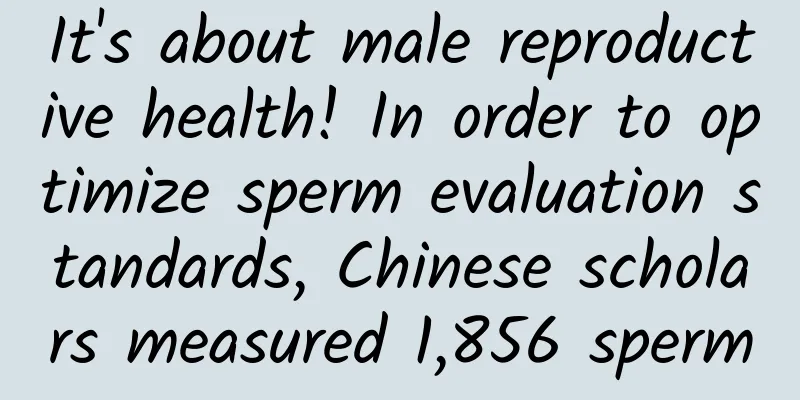It's about male reproductive health! In order to optimize sperm evaluation standards, Chinese scholars measured 1,856 sperm

|
What is “normal” sperm? Copyright images in the gallery. Reprinting and using them may lead to copyright disputes. Li Fuping, the corresponding author of the study and director of the Department of Reproductive Medicine at West China Second Hospital, said that 50% of infertile couples can be attributed to male factors, among which sperm morphology is an important indicator for evaluating male fertility. However, the relevant standards for what is normal sperm morphology have long been in a vague area. "Our research is to standardize and objectify the morphology of normal sperm and reshape its value in clinical diagnosis," said Li Fuping. Since 2020, he and his team have collected 1,856 sperm with normal morphology from normal fertile men, and for the first time developed 14 specific sperm head morphology parameters, in order to further provide a complete atlas for the diagnosis of reproductive medicine diseases across the country and even Asia. Overly strict sperm evaluation In 2023, the Department of Reproductive Andrology of West China Second Hospital/Sichuan Human Sperm Bank and Chongqing Human Sperm Bank launched a nationwide inter-laboratory quality assessment project for semen testing, with a total of 117 medical institutions from 24 provinces participating. Li Fuping introduced, "The data we collected found that in some units, as many as 80% to 90% of men were diagnosed with 'teratozoospermia'." Abnormal sperm refers to the morphological variations of the sperm head, body, and tail. Head deformities include giant head, amorphous, double head, etc. According to the "Manual of Laboratory Examination and Processing of Human Semen (6th Edition)" updated by the World Health Organization in 2021 (hereinafter referred to as the "Manual"), the head of a normal sperm should be smooth, with regular outlines, generally oval in shape, and the recommended ranges for sperm head length, width, and aspect ratio are given. It has long been a consensus in the academic community that sperm abnormalities can affect reproductive outcomes . As early as 1986, scientists discovered that the percentage of "normal" sperm morphology is strongly correlated with fertilization and pregnancy rates. " But a 90% abnormal sperm rate means that infertility can almost all be traced back to male factors, which is obviously inconsistent with common sense, " said Li Fuping. This is not just a confusion faced by domestic teams. The relevant controversy has lasted for more than ten years worldwide. In recent years, some scholars have even pointed out that the normality of sperm morphology has no correlation with the success rate of intrauterine insemination and the live birth rate. For example, a 2017 study found that among men who had no "normal morphology" sperm, 30% still achieved natural fertility. Li Fuping mentioned that the reason is that, on the one hand, the WHO's definition of normal and abnormal sperm morphology is only descriptive, which leads to differences in everyone's understanding. For example, vague descriptions such as "roughly elliptical" lead to subjectivity and inconsistency in morphological assessment. On the other hand, the data provided by the WHO is based only on 77 measurements of normal sperm size, and does not indicate the health status and fertility of the corresponding subjects, which also affects the universality of the standard. A series of uncertain standards have led technicians to be too strict in their sperm evaluation. "Currently, sperm morphology analysis relies on the technicians' naked eye assessment. According to the WHO Manual, when the boundaries are blurred, people tend to define sperm in ambiguous and critical ranges as abnormal, and the 'normal sperm' finally selected is actually 'perfect sperm'." But imperfection does not mean "abnormal". The reference lower limit of the percentage of normal sperm in men is set at 4% in the manual. As long as a man's normal sperm percentage is less than 4%, he will be defined as teratozoospermia. "As many as 96% of sperm are abnormal, including a large number of critical sperm, but they are not necessarily pathologically significant. So what is the significance of this indicator?" According to Li Fuping, such a "strict" standard has led to the loss of clinical diagnostic value of sperm morphology evaluation and increased the difficulty for doctors to decide whether to conduct assisted reproductive treatment. Setting sperm size standards for Asians What exactly is the normal form of sperm? "We used to think that the WHO Manual was the 'gold standard' and was unquestionable. But as more and more problems were encountered in clinical practice, including the regular updates by the WHO, we realized that we could do some research, and maybe the next version would include our data," said Li Fuping. In 2020, the Department of Reproductive Andrology of West China Second Hospital cooperated with relevant enterprises to establish the country's first fully automatic sperm morphology analysis system based on artificial intelligence. Since May 2020, the team has selected 54 participants from the Sichuan Human Sperm Bank. They are in good health and have a history of natural reproduction in the past year. At least 200 sperms were randomly captured from each person's semen sample. The system and technicians further selected a total of 1,856 sperms with normal morphology for measurement. According to the WHO Manual, the length and width of a normal sperm head are 3.7-4.7 μm and 2.5-3.2 μm respectively. Li Fuping's team further located the median values at 4.02 μm and 2.52 μm, with a length-to-width ratio of 1.59. In addition, the team expanded the original three parameters (length, width, and aspect ratio) to four categories (size, shape, area, and uniformity), totaling 14 specific parameters, including head circumference, ellipse fit, circumference fit, major axis symmetry, minor axis symmetry, etc. Taking the long and short axis fit as an example, the study found that the median values of healthy sperm are 94.3% and 92.1% respectively. "The long and short axis fit is to fold the sperm head up and down and left and right, and if it completely overlaps, it is 100%." According to Li Fuping, the sperm head should be oval, but there was no objective standard for how to define an oval, and everyone has different opinions. "We also measured the size of the sperm's acrosome, vacuoles, etc., and provided more detailed indicators as a reference for 'normal sperm'." Reproductive genetics may also have certain racial differences. The previous "Manual" did not give the specific skin color, regional distribution, etc. of the sperm source population. The latest research results further refined the numerical reference range to Asian yellow people. It is understood that since the research project was launched, Li Fuping's team has collected tens of millions of sperm. "The hardware system and research methodology have been established, and a series of work will continue to be carried out." Li Fuping said, "We are also measuring many different types of abnormal sperm, evaluating related size parameters, and correlating these data with the patient's clinical manifestations and reproductive outcomes. In this way, the clinical diagnostic value of sperm morphology can be gradually reflected." Prevent further damage to male reproductive health As the head of the Sichuan Human Sperm Bank, Li Fuping has been engaged in clinical and basic research on male reproduction for more than 20 years, exploring the impact of environment, lifestyle, disease, etc. on male reproduction. Li Fuping mentioned that the causes of sperm morphology abnormalities are complex and are composed of genetic factors, environmental factors, lifestyle habits, etc. "High temperatures, tobacco and alcohol, obesity, and increasingly severe environmental pollution are all considered high-risk factors for sperm morphology changes." On the other hand, the impact of age on male sperm cannot be ignored. "We generally believe that women's fertility will be greatly reduced after the age of 35, but we often ignore the relationship between sperm and age," said Li Fuping. Several studies have pointed out that the quality of male sperm does not differ much before the age of 40, but after the age of 40, sperm concentration, motility and normal morphology rate begin to decline significantly. Will changes in sperm morphology affect the health of offspring? According to Li Fuping, "Morphology is only one aspect. In clinical practice, other functional indicators will be combined, including sperm DNA fragmentation rate, as well as the condition of the woman's eggs, whether the couple has a family history of disease, etc., to provide comprehensive fertility guidance to the couple." However, it is an indisputable fact that the quality of male sperm has been declining year by year. Scholars from the Reproductive Medicine Center of Xi'an Jiaotong University and other institutions pointed out in a study that in the nearly 40 years from 1981 to 2018, the sperm concentration and total number of healthy Chinese men decreased by 36.95% and 28.13% respectively. At the 13th International Spermology Symposium in 2018, experts also called on governments to include declining male fertility as a major public health issue, study the causes of the continued decline, and take immediate and concentrated response measures. In fact, there is no absolute technical difficulty in accurately and in detail measuring various parameters of sperm morphology. The reason for the long-term lack of detailed data is "because the academic community pays less attention to male infertility, and male reproduction is only a sub-discipline under reproductive medicine, lacking a professional discipline training system." "In the past, most reproductive studies have focused on female fertility and assisted reproductive technology, believing that as long as the man has sperm, it will be fine." Li Fuping said, but the academic community has found that despite the growing development of assisted reproductive technology, clinical pregnancy rates and birth rates have reached a bottleneck level, and the role of sperm in assisted reproductive technology has been increasingly valued. "Eggs, sperm, and embryos are all indispensable. Without good sperm, the fertility outcome will naturally be affected." "At present, we have taken the lead in proposing the concept of reproductive andrology as a sub-discipline in the country, established an independent reproductive andrology department, and formulated a complete scientific research, clinical, training and quality control system." Li Fuping said, "We also hope that more medical institutions can pay attention to male reproduction, participate in the construction of related disciplines, and make efforts to protect male reproductive health." Planning and production Source: Medical World (ID: yixuejiezazhi) Author: Ling Jun Editor: Wang Mengru |
<<: Othello, a game with 10²⁸ variations, has been cracked by a supercomputer!
>>: Look! The sun is also "drawing"? It once caused power failure!
Recommend
Case study: How to make information flow advertising in the beauty industry more effective?
Women love beauty, forever Regarding why women lo...
My hair is falling out and my leg hair is growing. Who knows the pain of being teased as a "kiwi fruit" or a "yam stick"!
Why do some people have more body hair and some h...
How much does it cost to customize a mechanical equipment mini program in Chuxiong?
How much is the quotation for customized Chuxiong...
Operation skills and monetization methods of B station film and television accounts!
It is very easy to be an up master on Bilibili. A...
Android classic source code, a very good open source framework
High imitation of the most beautiful applicatio...
How to convert WeChat mini program into QR code?
WeChat mini programs have opened up entrances suc...
Perfect Diary’s private domain traffic method!
The article provides a detailed analysis of the t...
Massive Engine Interactive Advertising System
1. The shift in growth strategy in the stock gami...
The hot 2022 Chengdu new tea arrangement is worth collecting
Reservation arrangements for Chengdu new tea: 135...
90% of marketing copy will use these two directions to impress users!
The essence of marketing copy is to get users to ...
Dianca raises 2 billion yuan, round A financing has started, and will launch a high-end brand
It is reported that Diancha Automobile recently c...
A set of Excel animation tutorials worth 8800 yuan
For professionals, Excel is one of the software t...
How can medical and health products be accurately placed on Xiaohongshu to achieve high ROI?
For brands, Xiaohongshu has become an important p...
First exposure! This star orbits a black hole in a spaghetti-like shape
Astronomers have observed a massive black hole de...
Can water that enters the ears really flow into the brain? Come and "wash your ears and treat your brain"
Author: Chen Jiameng: The Sixth People's Hosp...









